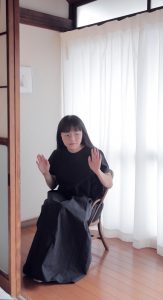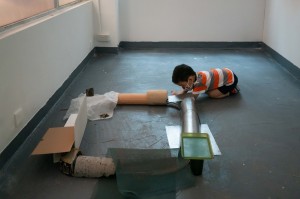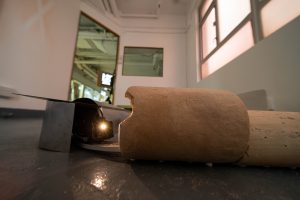artist support programme (ASP) alumni: Bunchi Chan Chor-kiu
「藝術家支援計劃」獲選藝術家:陳楚翹
閱讀完整訪談 (中文) >>>
–
Interview excerpt:
Bunchi Chan Cho-kiu (b.1990, Hong Kong) received her Bachelor of Arts degree from the Academy of Visual Arts, Hong Kong Baptist University in 2015. She uses installation and painting as her main media. Bunchi’s practice focuses on the materiality, the human interventions, and the inner aesthetics in daily objects. Exhibitions in which she has participated include the solo exhibition ‘Object Conference’ (Art Center Ongoing, Tokyo, 2017), ‘Münster Sculpture Project in Sagamihara 2018’ (Kanuma Park, Tokyo, 2018), and ‘Passengers’ Anecdotes’ (Hong Kong Fringe Club, Hong Kong, 2018), etc. She currently lives and works in Tokyo.
Bunchi Chan Cho-kiu was supported by soundpocket’s Artist Support Programme 2016–17.
Personal website >>>
–
20.5.2021 (Thu)|12 pm
Online interview (Tokyo:Hong Kong)
◎ Artist-in-residence and permanent residence: Continue walking
soundpocket: You moved to Japan in 2018 and now you are living as a permanent resident there. Before that, you stayed in Tokyo for a one-month artist-in-residence programme under ASP in 2017. What are the major differences between staying in Japan for a limited time and living there as a resident? Do you see any changes and what are they?
Bunchi: When I was visiting Tokyo for the first time as an artist-in-resident, I was very much distracted by things when I walked on the street – I wanted to explore everything around me. Now I am relatively calm because there is not much novelty left. Therefore, I start to look for what I want to see on the street. Sometimes I feel that what I am seeing is just an illusion; I do not think that I am getting used to the fact that I am living in Japan. When I spend time alone, my curiosity about the details of things around me is aroused. Now I have a habit of collecting “rubbish” from time to time – it started when I was on the residency programme, and I am still doing it. I am now more experienced in “rubbish” collecting. When people throw things away they are very tidy here, and the streets are very clean. I don’t notice much change and variation on the streets now I am living here; they look the same every day. This is totally different from what I saw in Hong Kong. Having lived in Hong Kong for so many years, I still think that the changes on the street are so rapid.
I have fantasies from my imagination about the objects that I collect. After bringing them home, I will experiment with them. For example, I will try to combine a few objects that I have collected, or dismantle them, or assemble them together with some other parts. I think it’s the objects that direct me to create my works, rather than that I am conscious of what the final result will be. I look for materials to complete my works. The reason why I like found objects is that they are alluring for my imagination. Their characteristics, appearance, and the sounds they make guide me through the creation of something new. I am just making use of these objects on the street that seem to be useless to shape, or “push”, them to a level that I like.
◎ About a son
soundpocket: After giving birth to your son, your daily routine became more regular. Places where you used to go for a walk were transformed into a playground. You were inspired and made use of your son’s toy train when you were creating the work “Transition”. Can you tell us about how the presence of your son affects the way you create or see objects?
Bunchi: I think it is more about the creative process. In the past, I did not like it when people saw me working on my own artworks. I would only ask for people’s comments when I was 99% done with the work – I did not want to explain what I was trying to do to others. Now, I have to allow my son to participate in my creative process. He is the “tester” of my works; he will surely touch everything I am working on. It is inevitable that my son will participate in my creative process – that he will touch, see and move the objects. This is a major change for me. On the choice of objects that I work on, it comes very naturally. If you see something too often, you will be easily inspired by it. I used toy trains in “Transition” because it was my son’s favourite toy. As we are talking about the work now, I realize that it is also because of my son that I built the tunnel. Out of curiosity, he wanted to know what was happening in the long and total-dark tunnel. His sensitivity inspired me – this made me aware of things that are present but invisible. The echo in the tunnel was also related to his participation. He was constantly listening to what was happening because he couldn’t see a thing in the total darkness, but he could tell if the trains had crashed just by listening. His sensitivity was much higher than mine. Sometimes such experiences become my work materials.
◎ Listening: Transition and adaptation
soundpocket: Through our conversation and your work, we can tell that you are still very concerned about what is happening in Hong Kong. Though you are not able to physically experience the city now, you are still trying to know more about the Hong Kong matters through different channels. Can you share with us from where, and how have you got to know about what is happening in Hong Kong over these few years? How does that experience affect your personal life and feelings? Have you projected these onto “Transition”?
Bunchi: It feels strange that while on the one hand I am overwhelmed by the news from the Hong Kong media and friends, and on the other I am in a city and environment where no one can actually share my emotions. I think, over these two years, we somehow acknowledged and understand that the dread of waiting is the most terrifying thing. Plus, the fact that there is so much filtering of the news, and I could not be there myself. Sometimes I felt quite stressed and hopeless when receiving the news from Hong Kong; I shared the same sorrows as everyone. But despite the reality of this news, I also felt a kind of delusion that no one draws or writes on walls, or that no-one views the cops with hatred in their eyes, because what was going on around me in Japan was just the celebration of the Olympic Games and gossip about some celebrities’ affairs.
Being here feels so much like “nothing has happened”, and this makes me feel a bit uncomfortable living here because I think no matter whether the vibe is good or bad, I have an urge to share it. But there is nothing that I can share with anyone here. Therefore, in my work, I have mentioned about “transition” and some moods – these are things that are distant, that have not reached their destination. They are more like something that you have been waiting for for some time, but there seems to be no end result. I cannot go back to Hong Kong and I have been constantly receiving news through different channels; this “transition” feels like a never-ending journey. I started to feel that I might never be able to go back to the Hong Kong that I knew, that I can never share the same vibe with the other people around me. Even if I could return to Hong Kong, some things might have already changed. This is exactly the way in which one is situated in a transitory process and journey, and the whole experience becomes a form of presence and a state of mind (and that was shown in the exhibited work).


